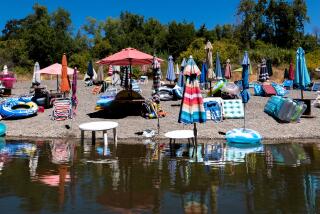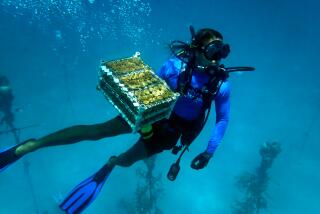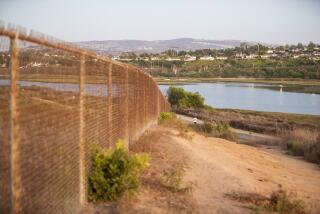An Upstream Struggle for Water’s Edge
- Share via
KEY WEST, Fla. — At midnight Sunday, Billy Niles will load 300 traps made of Honduran pine onto his boat, the G&D;, and just like he has done for more than half a century at the height of summer, will motor out into the waters surrounding the Florida Keys in search of lobster.
The third-generation commercial fisherman and conch, or Keys native, can reel off a daunting list of hardships these days for people in his livelihood: high prices for fuel and ice, foreign competition, a growing tangle of federal and state regulations, the risk of a hurricane. But what really worries Niles, 67, is that by the end of this coming eight-month lobster season, he may no longer have a place to moor his diesel-powered 53-footer.
“In Key West harbor, there used to be 400 to 600 shrimp and lobster boats, and seven to eight fish houses,” Niles said. “Now there ain’t a boat there, or a fish house.”
Finding access to saltwater in Florida might seem simple; the state, after all, is bounded on three sides by the sea. But these days, owners of the state’s more than 945,000 registered watercraft, from dinghies to mega-yachts, are increasingly finding their route blocked as developers snap up docks, marinas and other properties at the water’s edge.
Although the state has more than 1,300 miles of coastline, plus inland waterways, the pace of population growth and development, as well as the willingness of buyers to pay more and more for locations with a waterfront view, has transformed the shoreline so rapidly that this spring, the Legislature passed a law, signed by Gov. Jeb Bush last month, designed to help ensure the survival of the working waterfront.
In addition to helping fishermen, the law -- which empowers local governments to authorize a deferral of property taxes as long as the businesses and public docks in such areas maintain their present use -- was intended to support weekend boaters who need a place to launch, store or repair their sailboat or powerboat.
“The water-access issue is the top priority for Florida’s marine industry as more and more waterfront and recreational facilities are converted to high-end residential and other non-water-dependent uses,” said Frank Herhold, executive director of the Marine Industries Assn. of South Florida, a trade group based in Fort Lauderdale.
What’s happening in his area of Florida is typical, Herhold said. Fort Lauderdale and the rest of Broward County have about 100 marinas, boatyards and other public docking facilities. About 14 of those facilities, he said, have been lost recently to public use, or are being converted into high-end residential communities, called dockaminiums.
“We’re being paved over and privatized at a record rate,” Herhold said.
In the Miami area, as land along Biscayne Bay and the Atlantic shore has been built out, developers have been eyeing the banks of the Miami River, which is home to the state’s fourth-largest port, handling 1 million tons of cargo a year. The result, said port director Fran Bohnsack, is a “madness of property speculation” that has pushed real estate prices to unheard-of levels and could price shipping companies and related industries off the river.
One of the port’s few working boatyards has been bought by an owner who wants to demolish it and erect three high-rise towers with a total of 1,100 residential units on the site, Bohnsack said.
“I see the faces of people every day who depend on this river for their livelihood,” she said. “There is worry, concern, anxiety and anger, because they are so completely discounted, and there is not even a token effort to protect some of these jobs.” Miami’s elected leaders, Bohnsack said, seem to give property developers whatever they ask for.
In October, a developer bought a marina in Clearwater on the Gulf of Mexico, with the intention of turning it into luxury condominiums. “It was just one more way that the citizens of Pinellas County lost access to the waterways,” state Rep. Kimberly Berfield said.
Her constituents had complained for years that it was getting harder to find a marina where they could put their boat in the water for a family weekend cruise, the Clearwater Republican said. But it was the marina’s conversion that led her to sponsor the new state law. “Somebody had to step forward and make sure that the natural resources that so many people come to Florida to use continue to be available to them,” Berfield said.
In Palm Beach County, the loss of a marina led voters last November to approve a $50-million bond issue to buy out the development rights of remaining marinas to ensure they wouldn’t sell out to a builder of waterfront high-rises. Elsewhere in southeastern Florida, Broward County has commissioned a study of the problem, and Martin County is considering a “no net loss” policy, which would require marina owners to build new slips somewhere else if they changed the use of an existing property.
Nowhere, however, does the water-access problem appear to be more acute than in the Keys, the island chain that arcs south of the Florida peninsula toward Cuba.
Displaced in recent years by pricey condominiums, docks catering to the yachts of the well-to-do and other upscale construction, Key West’s commercial fishing industry has retreated to unfashionable Stock Island, fringed by mangroves and far from the city’s usual tourist haunts. But on Stock Island, where the air last week was filled with mosquitoes and the tang of the cowhide used to bait lobster traps, the economics have been changing too.
“As all of the waterfront has been taken there [in downtown Key West], and prices have been driven up, this looks more appealing here,” said Peter M. Bacle, owner of Stock Island Lobster Co., a fish house that provides docks, storage facilities and credit to commercial fishing boats in exchange for discounts on their catch.
In the last six months, two fish houses on Stock Island have closed, leaving just three big ones. The old waterside businesses likely will be reborn as dockaminiums, where boat owners would buy individual slips at higher prices.
“Losing the waterfront is the biggest problem we’ve got now,” said Niles, the commercial fisherman. His son, who fishes lobster and mackerel, has carried the family trade into the fourth generation.
Throughout the Keys, at least 43 motels, RV campgrounds, marinas and other properties where people could once launch or repair boats, or just swim or look at the water, have been sold for conversion into gated communities or other private uses, or are now being sold, said David P. Rice, a Monroe County commissioner. That’s about a quarter of all the businesses that currently make up the working waterfront in the Keys, county officials said.
“Unless we somehow protect public access to the water for a variety of uses, we won’t have it in a short period of time,” Rice said.
Though lawyers for some property owners objected to any special restrictions, Rice and the four other county commissioners last week approved a 270-day moratorium on any changes in the use of working waterfront properties in the Keys. The break is meant to allow time to study what sort of access to the water boaters and commercial fishermen now have, and what improvements could be made. The ultimate solution, Rice said, may be for the county to save marinas by buying them.
On Stock Island, Niles said, he and other fishermen are worried about losing the dock space where they tie their boats. As he got ready for another lobster season, Niles seemed skeptical that the moratorium would help.
“Little by little, they’ve kept pushing us further out,” Niles said as he tied yellow, orange and white floats with polyethylene rope to mark his orange-crate-sized traps. In the 1970s, he and his colleagues began getting priced out of Key West’s harbor, he remembered. “Now the same thing is happening here,” he said.
More to Read
Sign up for Essential California
The most important California stories and recommendations in your inbox every morning.
You may occasionally receive promotional content from the Los Angeles Times.










